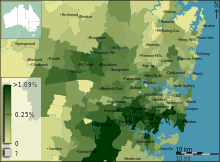Egyptian Australians
| Total population | |
|---|---|
|
70,000+ (by ancestry, 2006)[1] 36,532 (by country of birth, 2011)[2] | |
| Regions with significant populations | |
| Sydney, Melbourne, Perth, Canberra, Adelaide, Newcastle, Brisbane | |
| Languages | |
| Australian English, Egyptian Arabic, Coptic, Nobiin, Sa'idi Arabic | |
| Religion | |
|
Christianity (Majority) Islam, Bahá'í, Judaism (Minority). | |
| Related ethnic groups | |
| Egyptians, Copts, Coptic Australians Egyptian diaspora, Arab Australians, Egyptian Americans, Egyptian Canadians |

Egyptian Australians are Australian citizens and Australian permanent residents of Egyptian descent. According to the Australian 2011 Census, 36,532 Australian citizens and permanent residents declared that they were born in Egypt,[2] while based on the 2006 Census, at least an additional 31,786 declared that they were of full or partial Egyptian ancestry and born in a country other than Egypt (including most numerously Australian-born persons of full or partial Egyptian ancestry).[1]
An additional 1,890 persons in the 2006 Census reported themselves as being of "Coptic" ancestry. The term Coptic ordinarily refers to adherents of Coptic Christianity, but when used as a term referring to ethnicity means "Egyptian" (almost always in the context of Coptic Christian Egyptians). The 1,890 persons who described their ancestry as "Coptic" are thus most likely Egyptian Australians.[1]
Copt as an ethnonym is etymologically derived from the Greek "Aiguptious," literally meaning "Egyptian," from the Late Egyptian word "Gyptios", via the Classical Arabic "Qubt", into the English "Copt". The word ordinarily refers to Coptic Christian Egyptians, though there have been instances of Muslim Egyptians referring to themselves as "Copts" to emphasise the non-Arabian ancestral origin of Egyptians in general.
The 2006 Census shows that the majority of Egypt-born Australians are located in Sydney (16,238) or Melbourne (11,156), with smaller communities located in Perth (1,407), Adelaide (982) and Brisbane (897).[3]
The majority of Egyptian Australians are Christians, which is in contrast to the religious affiliation to Islam of the majority of the population of ethnic Egyptians within modern Egypt. Centuries of a steady continuous rate of conversions of the local indigenous Egyptian population has resulted in modern Egypt's Muslim majority, although the indigenous Christian Church of Egypt has retained a sizeable minority throughout its history, up until today. Christians comprise much of the Egyptian diaspora, both in Australia and elsewhere. The majority religion of Egypt before the introduction of Islam from Arabia was Christianity, and prior to introduction of Christianity to Egypt the majority religion was the Ancient Egyptian religion.
Some 19,928 Australian citizens and residents declared membership of the Coptic Orthodox Church at the 2006 Census.[4] Most Egyptian Christians, however, may simply have declared themselves "Christian" without specifying the Coptic denomination, while other Egyptian Christians may belong to various other denominations, either born into or converted. In 2003, however, it was claimed in the New South Wales Parliament that there were in fact 70,000 Copts in New South Wales alone.[5]
Emigration from Egypt was significant in the late 1940s and 1950s, disproportionately so for non-Muslim religious minorities escaping the growing Arab nationalist movement in Egypt which saw the overthrow of the Egyptian monarchy and the subsequent Suez Crisis.[6]
In total numbers, Egyptian Christians were the largest contingent of emigrants to leave Egypt for other countries, including to Australia. Christians were the second largest in terms of proportion to their original community size in Egypt. Egyptian Jews, as a proportion of their original community size in Egypt, were the largest emigrant community to leave Egypt (they were the second largest in total numbers). The number of Jews in Egypt numbered around 75,000 in 1948, and following the establishment of the State of Israel that same year, almost the entire population left in the subsequent years during the Jewish exodus from Arab lands, settling largely in Israel, USA, Europe, Latin America, and around 2,000 settling in Australia.[7] The Egyptian Jewish population in Australia is concentrated particularly in Adelaide, South Australia.[8] Officially, only 6 Jews remain in Egypt today.[9]
Notable people
- Ahmed Saad
- Anne Azza Aly
- Aziza Abdel-Halim
- Taj El-Din Hilaly
- Robert Kabbas
- Naguib Kanawati
- Amir Elsaid
- Akmal Saleh
- Sam Soliman
- Michael Missak
- Joseph Tawadros
- Bishop Angaelos
- Waleed Aly
- CAPTIAN ABDALLA SRHAN
See also
References
- 1 2 3 "20680-Ancestry (full classification list) by Sex - Australia" (Microsoft Excel download). 2006 Census. Australian Bureau of Statistics. Retrieved 2008-06-02. Total responses: 25,451,383 for total count of persons: 19,855,288.
- 1 2 "2011 QuickStats Country of Birth (Egypt)". Censusdata.abs.gov.au. Retrieved 2013-05-22.
- ↑ "Redirect to Census data page". Censusdata.abs.gov.au. Retrieved 28 August 2017.
- ↑ "Redirect to Census data page". Censusdata.abs.gov.au. Retrieved 28 August 2017.
- ↑ "Coptic Orthodox Church (NSW) Property Trust Amendment Bill". Parliament of New South Wales, Hansard. 12 November 2003. Archived from the original on 4 March 2015.
- ↑ "Origins: History of immigration from Egypt - Immigration Museum, Melbourne Australia". Museumvictoria.com.au. Retrieved 28 August 2017.
- ↑ "The Migration Experience of the Jews of Egypt to Australia 1948 – 1967, Rachel Marlene Barda" (PDF). Ses.library.usyd.edu.au. Retrieved 28 August 2017.
- ↑ Network, Jewish Australia Online. "Jewish Australia". Jewishaustralia.com. Retrieved 28 August 2017.
- ↑ "Egypt's Jewish community diminished to 6 women after death of Lucy Saul - Egypt Independent". Egyptindependent.com. 30 July 2016. Retrieved 28 August 2017.
External links
- Coptic Orthodox Electronic Publishing Australia
- Coptic Orthodox Diocese of Melbourne
- Coptic Theological College of Sydney Australia
- Paul Ashton and Stephanie Ho - University of Technology, Sydney (2008). "Egyptians". Dictionary of Sydney. Retrieved 4 October 2015. (Egyptians in Sydney)